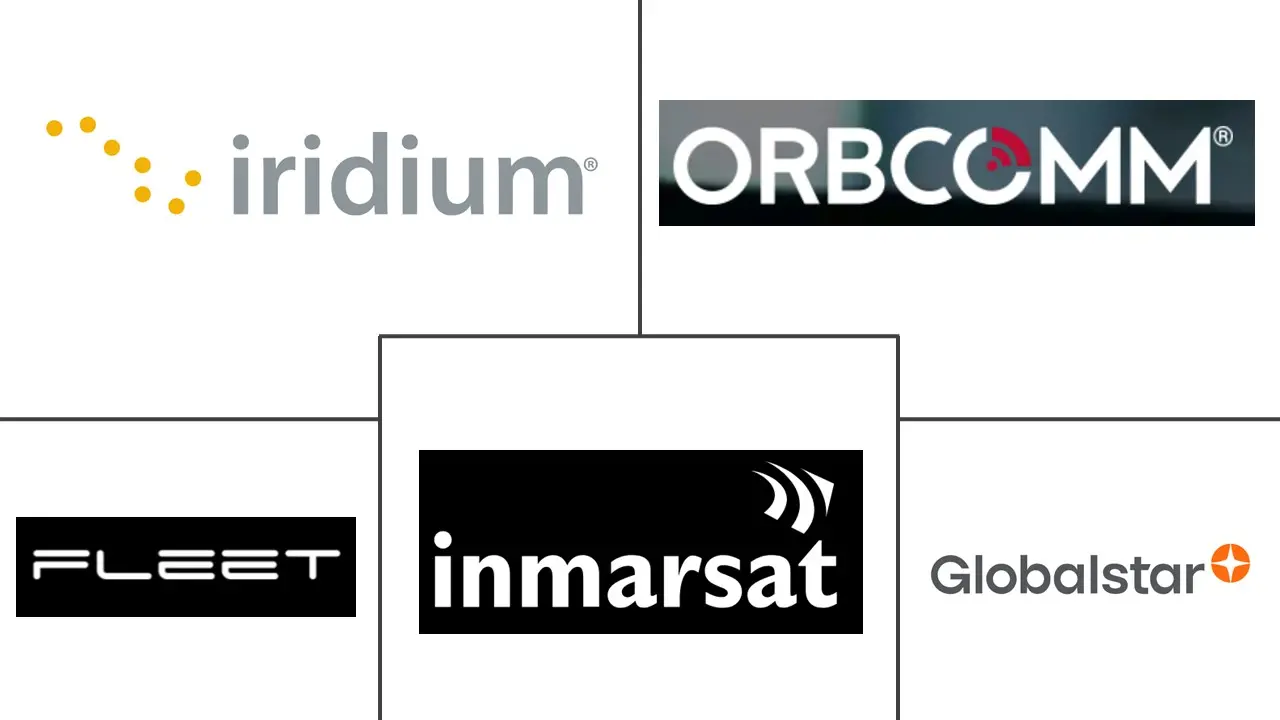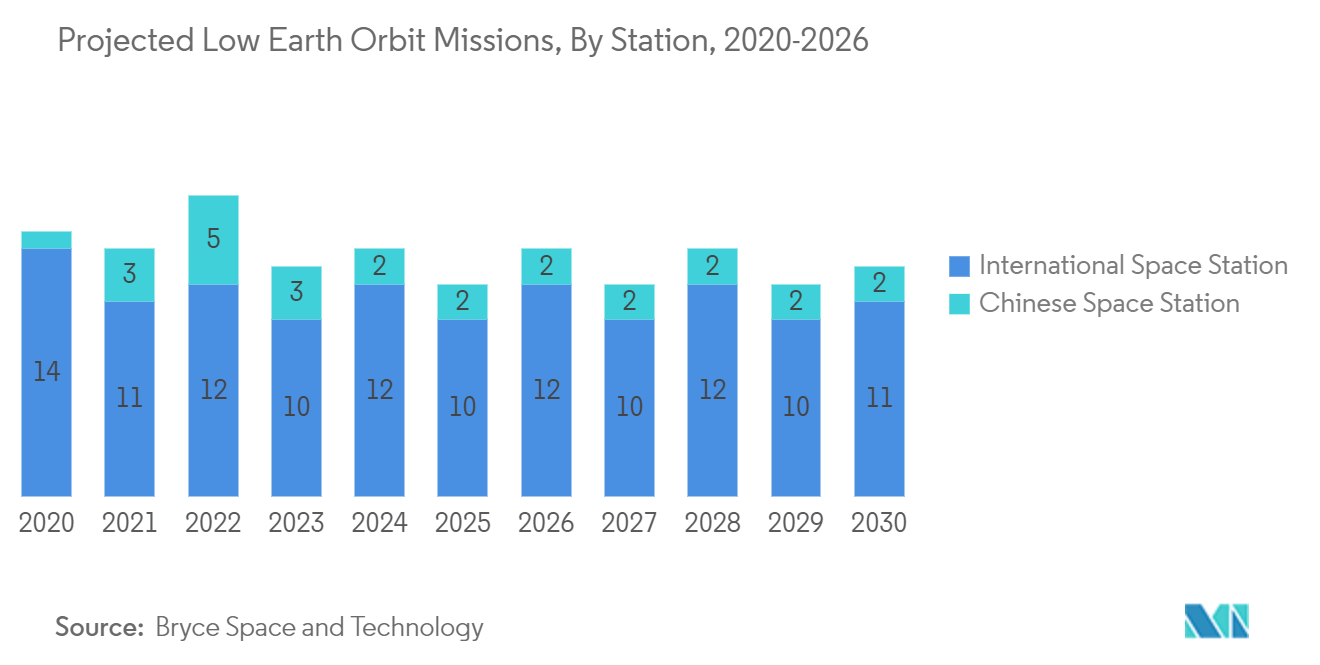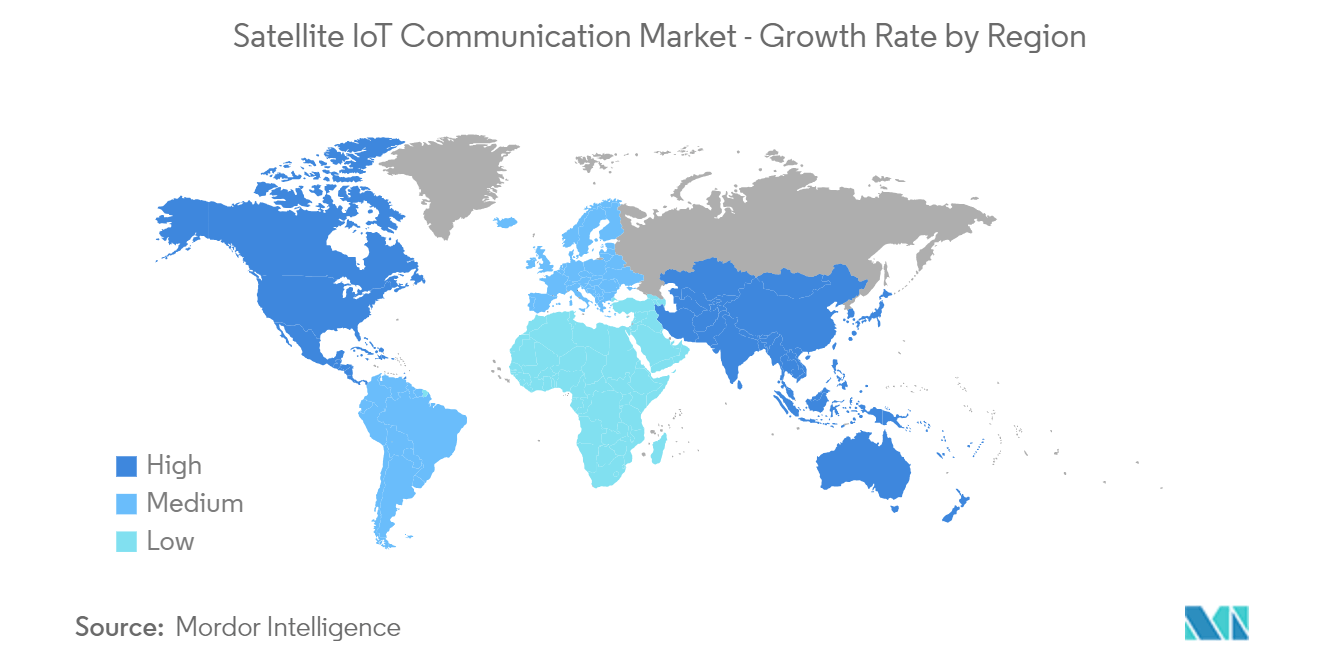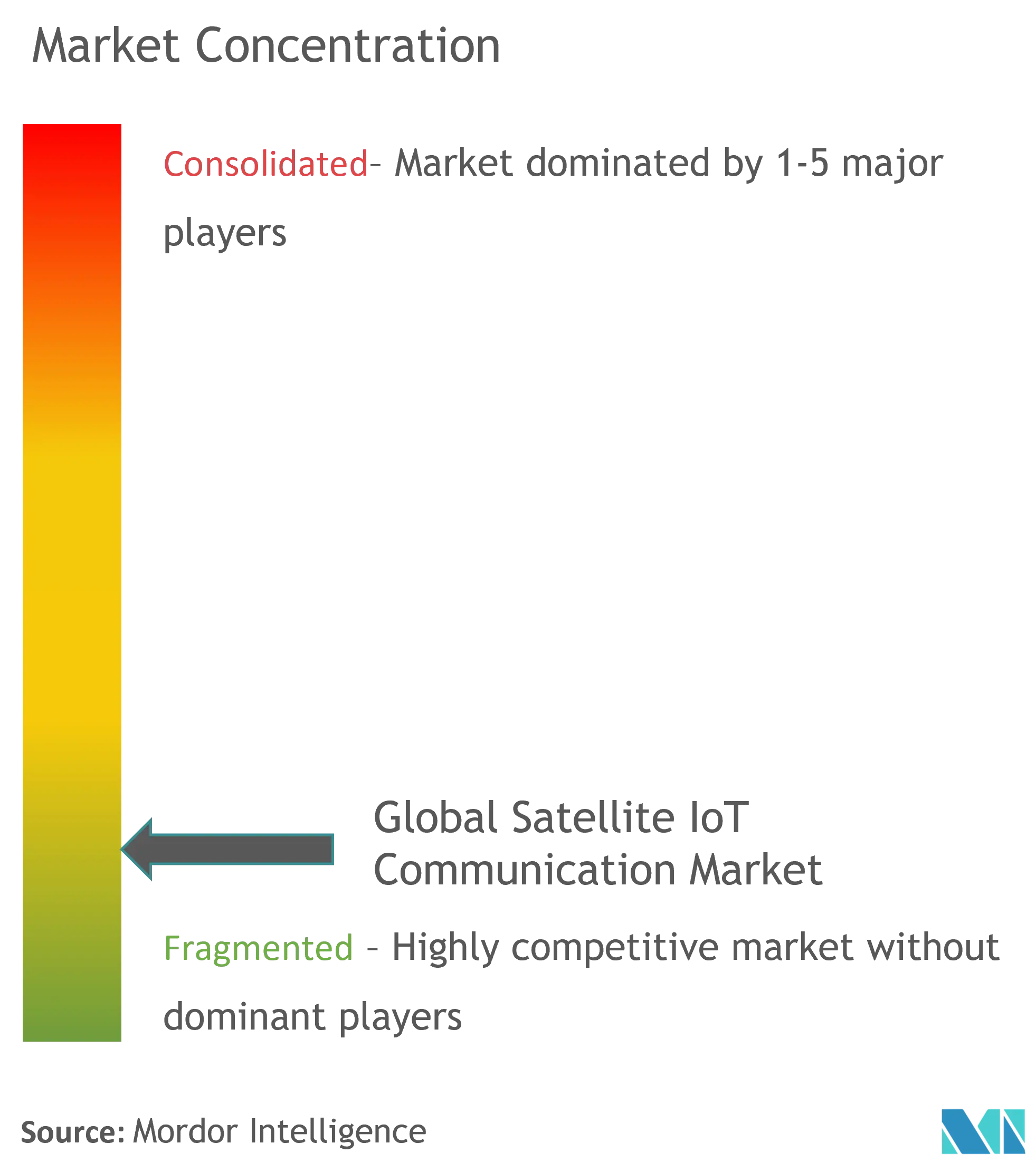Satellite IoT Communication Market Size

| Study Period | 2019 - 2029 |
| Market Size (2024) | USD 1.87 Billion |
| Market Size (2029) | USD 4.61 Billion |
| CAGR (2024 - 2029) | 19.76 % |
| Fastest Growing Market | Asia-Pacific |
| Largest Market | North America |
Major Players
*Disclaimer: Major Players sorted in no particular order |
Satellite IoT Communication Market Analysis
The Satellite IoT Communication Market size is estimated at USD 1.87 billion in 2024, and is expected to reach USD 4.61 billion by 2029, growing at a CAGR of 19.76% during the forecast period (2024-2029).
Satellite communication complements terrestrial cellular and non-cellular networks in remote locations, which benefits various industrial applications. 5G ecosystems would be a key trend in seamlessly integrating satellite and terrestrial networks.
- The drive for satellite communications stems from the pressing need for global connectivity for the Internet of Things (IoT) devices. Several businesses in this sector are investing in broadening the applications for satellite communication, most notably with the introduction of SmallSat constellations. Several businesses use satellite IoT services to monitor and track equipment for intelligent data transfers.
- The Global satellite Internet of Things communication market is driven by the development and growth of 5G wireless connectivity. The demand for more interaction between open and standardized ecosystems on both sides is emerging as a result of the growing number of efforts to expand 5G connection via LEO satellites, such as SAT 5G (a 5GPPP project supported by the European Union) and Metro Ethernet Forum (MEF). Building a safe, heterogeneous satellite and terrestrial 5G network would also aid telecom operators and LEO satellite providers better integrate their services.
- Considerable Investments in the LEO Satellite Market are a significant aspect boosting the growth of the satellite IoT Communication Market. The investments have been fueled by adaptability, cheap cost, advanced mechanics, simplicity of assembly and launch, mass production, and short life cycles, which would drive market growth in the coming years.
- Moreover, the growing trend of adopting autonomous systems and connected devices in the industrial sectors positively influences the market studied. According to Ericsson, by the end of 2028, almost 60 percent of cellular IoT connections are forecast to be broadband IoT, with 4G connecting the majority. This would create ample opportunities for the market to grow and enhance throughout the forecast period.
- Extreme Space temperature is a critical factor that could restrain the market. Satellites are exposed to the harsh environment of space, which makes the electronic components housed inside the satellites threatened by extreme temperatures. Hence satellites must maintain operational temperatures to avoid system failures so that communication is not affected.
- The COVID-19 pandemic caused shockwaves across every industry worldwide. It had a significant effect on the satellite IoT communication sector. The sector may be protected from the more severe effects of the global pandemic due to its reliance on government contracts in several areas, including the highly dependable and durable nature of satellite communications services, which are essential for disaster communications and backup services. However, there has been an increasing rise in access to terrestrial connectivity services after the pandemic, which left a significant opportunity for satellite IoT communications.
Satellite IoT Communication Market Trends
Low Earth Orbit (LEO) drives the Growth of the Satellite IoT Communication
- Low-Earth Orbit (LEO) satellite constellations, which orbit between 160 and 2000 kilometers above the Earth, are potentially attractive for expanding 5G connectivity to isolated, underserved, and remote geographies where terrestrial coverage is absent. Only about 10 % of the Earth's surface has access to terrestrial connectivity services, which leaves a significant opportunity for satellite IoT communications on the LEO constellations.
- LEO satellites attract significant investment from major players due to their adaptability, affordability, advanced mechanics, and ease of assembly and launch. The satellites have a short lifecycle and are mass-produced. There is a significant demand for low-cost, high-speed internet in the government and commercial sectors like retail, banking, oil, and gas. Also, the need for internet access in rural areas among individual consumers in emerging countries is driving investments in LEO constellations.
- LEO are better suited to low-power communications and lower signal propagation losses, reducing the user equipment's power requirements and making it ideal for contact with low-power IoT devices. Today, most of the LEO satellites for IoT are built mainly for leveraging CubeSat technology, allowing companies to mass-produce components and provide commercial off-the-shelf parts, drastically reducing the cost and time to design and develop satellites. It has become the desired option for incumbent satellite operators and NewSpace start-ups launching satellite IoT communication services.
- Moreover, to increase their consumer base and better meet their demands across various applications, significant companies are also investing, merging with other businesses, and investing in new projects. For instance, in April 2023, Sateliot, the first company to operate a low-Earth orbit (LEO) nanosatellite constellation with 5G-IoT standard, introduced Sateliot_0 "The GroundBreaker," the first-ever 5G standard LEO satellite, to democratize access to the Internet of Things.
- In February 2023, Rivada Space Networks GmbH (RSN), an entirely owned subsidiary of U.S.-based Rivada Networks, Inc., engaged Terran Orbital's wholly owned subsidiary Tyvak Nanosatellite Systems, Inc. to manufacture 300 low-earth-orbit (LEO) satellites for Rivada's innovative "network in the sky." RSN's space-based data network will provide fiber-like low latency and gigabit-per-second data delivery which is ultra-secure and extremely resilient.

North America is Expected to Hold Largest Share
- North America holds a significant share of the Satellite IoT Communication market. The growth is attributed to the growing government spending on military and communication networks. The presence of key significant players, such as Honeywell International, Inc., General Dynamics Corporation, L3Harris Technologies Corporation, and many others, drive the market growth significantly across the region.
- 5G networks play a vital role in assisting policymakers and governments in transforming cities into smart cities, allowing inhabitants to participate and realize socioeconomic benefits from an advanced, digital, data-intensive economy. As a result, authorities would be required to build and upgrade passive assets, such as fiber networks and data centers, which strive to meet the demand for the satellite IoT Communication Market.
- Moreover, the rise in the demand from end-user industries, such as government, agriculture, mining, energy, maritime, and aviation, is enhancing the market growth in the region. Moreover, the region has improved network connectivity and advanced foothold technological infrastructure. For instance, In August 2022, Inmarsat and hiSky created a new scalable IoT solution to provide a cost-efficient offering to IoT adopters while improving connectivity.
- In June 2023, Qualcomm Technologies, Inc. declared two modem chipsets with satellite capability: the Qualcomm 9205S Modem and the Qualcomm 212S Modem. The new Qualcomm modem chipsets primarily power off-grid industrial use cases that need a standalone non-terrestrial network (NTN) connectivity or hybrid connectivity alongside terrestrial networks and enable IoT developers, enterprises, OEMs, and ODMs to harness the key real-time information and insights especially to manage various business projects.
- Also, in December 2022, Iridium Communications Inc. declared the service launch of Iridium Messaging TransportSM, a two-way cloud-native networked data service primarily optimized for use over Iridium Certus and built to make it easier to combine satellite connections to the existing or new IoT solutions. IMT delivers an IP data transport service unique to the Iridium network, built for small-to-moderate messages assisting satellite IoT applications. Integrated with Iridium CloudConnect and Amazon Web Services, the new service can minimize the development costs and the speed time to market for various new Iridium Connected® IoT devices.

Satellite IoT Communication Industry Overview
The satellite IoT communication market is highly competitive and consists of several major players, such as Astrocast, Inmarsat Technologies, Kepler Communications, Ligado Networks, Galaxy Space, and Geely. Only some significant players currently dominate the market in terms of market share. With a prominent market share, these major players focus on expanding their customer base across foreign countries. These companies leverage strategic collaborative initiatives to increase their market share and profitability. Some of the key developments are:-
In March 2023, Quectel Wireless Solutions, a worldwide IoT solutions provider, launched the CC200A-LB satellite module for IoT industries that uses satellite IoT connectivity offered by ORBCOMM, a worldwide provider of IoT communications and solutions. The module is mainly built to deliver reliable global connectivity and coverage at a cost-effective price point and with ultra-low latency. It is a perfect solution for a vast spectrum of applications, including transportation, maritime, heavy equipment, mining, agriculture, and oil and gas monitoring.
Marlink, a global satellite and terrestrial network solution provider, and OQ Technology, the low Earth orbit (LEO) 5G IoT satellite communications company, signed an MoU for a global distribution partnership towards the distribution of Satellite 5G connectivity and hardware that is compatible with an existing cellular network and based on the 3gpp 5g non-terrestrial network cellular standard.
T-Mobile US and Starlink announced a technology partnership to develop a direct satellite-to-device proposition, which was expected to launch by 2024. Similarly, US-based Omnispace collaborated with the Philippines' mobile operator Smart, a subsidiary of PLDT, to explore interoperability between Smart's 5G network and Omnispace's LEO satellites, using 3GPP-compliant 5G NTN standards.
Satellite IoT Communication Market Leaders
-
Iridium Communications Inc
-
Orbcomm
-
Inmarsat Global Limited
-
Globalstar Inc
-
Fleet Space Technologies Private Limited
*Disclaimer: Major Players sorted in no particular order

Satellite IoT Communication Market News
- October 2023 - An SAR1 billion (USD 266.6 million) contract has been signed with the Hong Kong space company, which will set up satellite manufacturing facilities in Saudi Arabia. ASPACE will continue to increase its investment in line with the project phases, including R&D, component production, subsystems, and final assembly of satellites, as the Kingdom cements its position as a global manufacturing hub for foreign companies. By investing in advanced satellites, which represent 70% of the global satellite market, this deal will ensure that ASPACE is leveraging the strategically located region to improve its space capabilities.
- February 2023: Hispasat, a Spanish communications satellite provider, launched the Amazonas Nexus, bringing a new era in satellite communications. It is a high-performance geostationary satellite that will enable high-speed internet connectivity throughout the Americas, the northern and southern Atlantic corridors, and off-the-grid locations like Greenland and the Amazon rainforest. It was specifically created to provide connections on ships and airplanes and would significantly aid in bridging the digital gap in Latin America quickly and effectively.
- February 2023 : Cobham Satcom and RBC Signals, a global satellite data communication solutions provider, have announced an extended agreement to deploy Cobham Satcom's adaptable Tracker 6000 and 3700 series ground stations globally. The collaborative partnership between the two parties will dramatically expand RBC Signals' vast owned and partner ground network, providing integrated communication services to NGSO missions and constellations for Earth Observation, IoT, and Space Situational Awareness.
Satellite IoT Communication Market Report - Table of Contents
1. INTRODUCTION
- 1.1 Study Assumptions and Market Definition
- 1.2 Scope of the Study
2. RESEARCH METHODOLOGY
3. EXECUTIVE SUMMARY
4. MARKET DYNAMICS
- 4.1 Market Overview
-
4.2 Market Drivers
- 4.2.1 Development and Growth of 5G Wireless Connectivity
- 4.2.2 Considerable Investments in the LEO Satellite Constellations
-
4.3 Market Challenges
- 4.3.1 Extreme Space Temperature
-
4.4 Industry Attractiveness Model - Porter's Five Forces Analysis
- 4.4.1 Bargaining Power of Consumers
- 4.4.2 Bargaining Power of Suppliers
- 4.4.3 Threat of New Entrants
- 4.4.4 Threat of Substitute Products
- 4.4.5 Intensity of Competitive Rivalry
- 4.5 Industry Value Chain Analysis
- 4.6 Impact of COVID-19 on the Document Management Market
5. MARKET SEGMENTATION
-
5.1 By Type of Orbit
- 5.1.1 Low Earth Orbit (LEO)
- 5.1.2 Medium Earth Orbit (MEO)
- 5.1.3 Geostationary Orbit (GEO)
-
5.2 By Geography
- 5.2.1 North America
- 5.2.2 Europe
- 5.2.3 Asia-Pacific
- 5.2.4 Rest of the World
6. COMPETITIVE LANDSCAPE
-
6.1 Company Profiles
- 6.1.1 Iridium Communications Inc.
- 6.1.2 Orbcomm
- 6.1.3 Inmarsat Global Limited
- 6.1.4 Globalstar Inc
- 6.1.5 Fleet Space Technologies Private Limited
- 6.1.6 Viasat, Inc
- 6.1.7 Cobham Limited
- 6.1.8 Boeing
- 6.1.9 L3Harris Technologies
- *List Not Exhaustive
7. INVESTMENT ANALYSIS
8. MARKET OPPORTUNITIES AND FUTURE TRENDS
** Subject To AvailablitySatellite IoT Communication Industry Segmentation
Satellite IoT refers to using satellite communication services and networks to connect terrestrial IoT sensors and end nodes to a server (e.g., in a private or public cloud), either in alternative with or in conjunction with terrestrial communication networks.
The Satellite IoT Communication Market is segmented by Type of Orbit (Low Earth Orbit (LEO), Medium Earth Orbit (MEO), and Geostationary Orbit (GEO)), by Geography (North America, Europe, Asia-Pacific, and the Rest of the World). The market sizes and forecasts are provided in terms of value in USD for all the above segments.
| By Type of Orbit | Low Earth Orbit (LEO) |
| Medium Earth Orbit (MEO) | |
| Geostationary Orbit (GEO) | |
| By Geography | North America |
| Europe | |
| Asia-Pacific | |
| Rest of the World |
Satellite IoT Communication Market Research FAQs
How big is the Satellite IoT Communication Market?
The Satellite IoT Communication Market size is expected to reach USD 1.87 billion in 2024 and grow at a CAGR of 19.76% to reach USD 4.61 billion by 2029.
What is the current Satellite IoT Communication Market size?
In 2024, the Satellite IoT Communication Market size is expected to reach USD 1.87 billion.
Who are the key players in Satellite IoT Communication Market?
Iridium Communications Inc, Orbcomm, Inmarsat Global Limited, Globalstar Inc and Fleet Space Technologies Private Limited are the major companies operating in the Satellite IoT Communication Market.
Which is the fastest growing region in Satellite IoT Communication Market?
Asia-Pacific is estimated to grow at the highest CAGR over the forecast period (2024-2029).
Which region has the biggest share in Satellite IoT Communication Market?
In 2024, the North America accounts for the largest market share in Satellite IoT Communication Market.
What years does this Satellite IoT Communication Market cover, and what was the market size in 2023?
In 2023, the Satellite IoT Communication Market size was estimated at USD 1.56 billion. The report covers the Satellite IoT Communication Market historical market size for years: 2019, 2020, 2021, 2022 and 2023. The report also forecasts the Satellite IoT Communication Market size for years: 2024, 2025, 2026, 2027, 2028 and 2029.
Satellite IoT Communication Industry Report
Statistics for the 2024 Satellite IoT Communication market share, size and revenue growth rate, created by Mordor Intelligence™ Industry Reports. Satellite IoT Communication analysis includes a market forecast outlook to for 2024 to 2029 and historical overview. Get a sample of this industry analysis as a free report PDF download.



